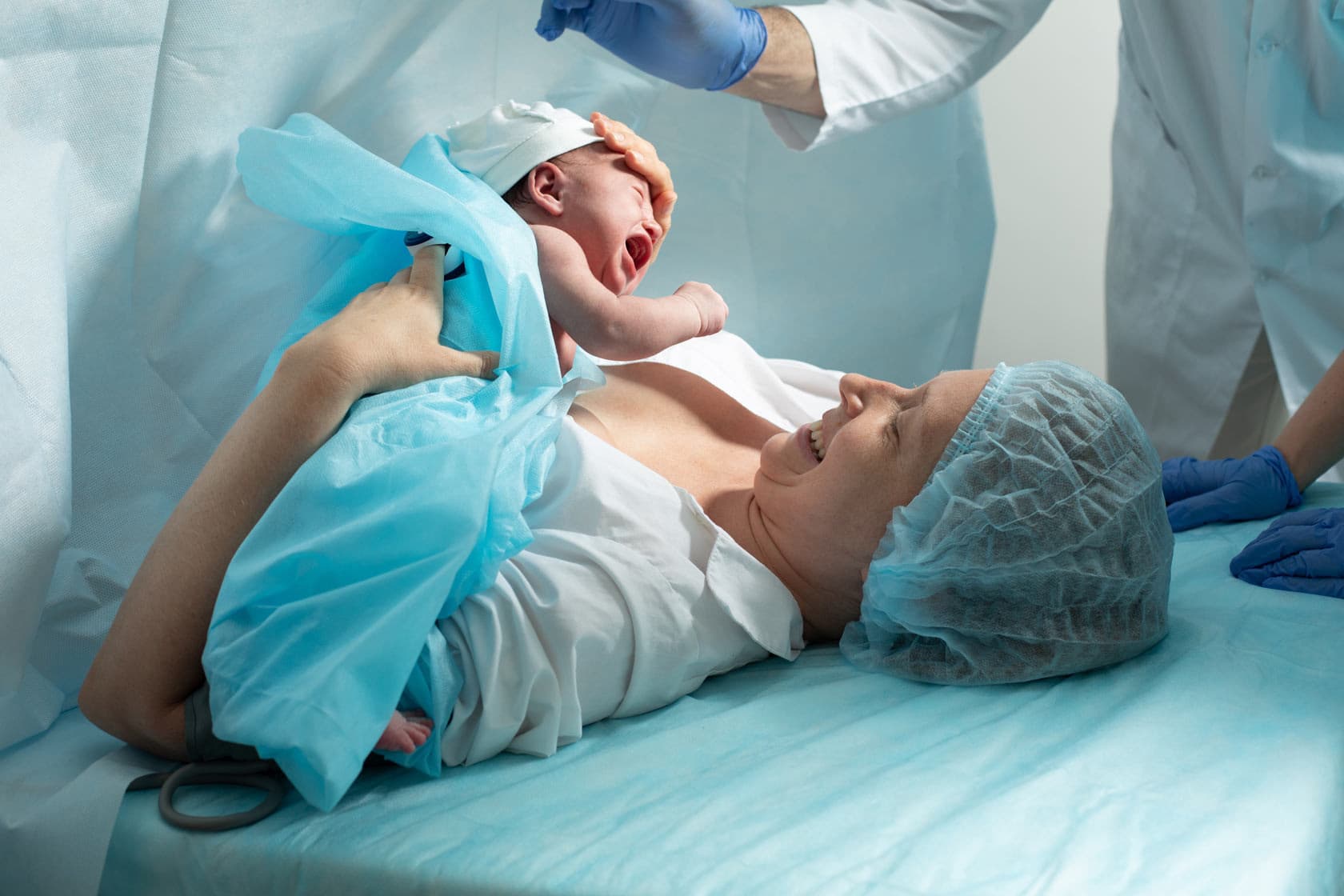Are Hospital Births or Home Births Safer?
Article by:
Dr. Raymond Obomsawin |
11 min read
The knowledge and practice of midwifery constituted an integral part of the traditional health care system of Canada’s first peoples. As an indispensable feature of traditional life, its practice accorded Aboriginal women a source of recognition and esteem in the community. The role of a woman as counselor and midwife was understood to be the Creator's calling to a very special profession.
Traditional Aboriginal midwives were considered as fundamental in the childbirth process and in transmitting ethical values from one generation to the next. Elders can recall that pregnancy and childbirth took place on a closely knit basis linking the midwife to the birthing woman, the infant, the husband and father, the extended family, and the entire community.
However, in the post-contact era there came over time the loss of the right for midwives to assist with birth within their traditional territories. Colonialism, the impositions of western medicine, the residential school system, and government legislation all served to alter the socioeconomic and traditional ways of Aboriginal people and undermined many of their long-standing healing traditions. The combined impact of these forces, in addition to major deterioration in health status, played havoc on Aboriginal cultures and undermined the previous balance and harmony within their communities.
In recent years, Canada has faced a shortage of maternity care providers that grows more acute every year. This shortage is felt most acutely in rural and remote communities and has fostered an increased acceptance of midwives as appropriate care providers for low-risk pregnancies.
For Aboriginal communities, this situation has provided greater opportunity for the restoration of midwifery and community-based births. Indeed, current efforts are underway in a limited number of regions in Canada to revive traditional midwifery in Aboriginal communities. Despite the obvious need, it has proven to be a difficult task. Many of the older practices have been lost and few Aboriginal midwives are left to pass along what survives of their Indigenous knowledge.
As an encouraging note, emerging forms of Aboriginal midwifery demonstrate an attempt to blend both traditional and modern forms of midwifery in order to create innovative models that focus on culturally relevant, community-based care.
Safety Issues
Perhaps the chief impediment to this movement taking full swing in all regions of Canada has been the misconception on the part of both medical professionals and lawmakers that high-tech hospital births are superior safety-wise to midwife-assisted births in more family-based settings, such as the home. Although there can be some risks involved in childbearing, in the vast majority of cases pregnancy and childbirth are normal functions of a healthy body, and not a life or death crisis that requires the supervision of high technology and surgical intervention.
With fewer high-tech hospitals and obstetricians than are found in North America, many countries such as Holland, Sweden and Denmark employ midwives as the primary care-givers for healthy women during their pregnancies and births. Statistically, such countries have the highest birth survival rates in the world.
In recognition of this fact, and understanding the potential dangers of the overuse of childbirth technology, the World Health Organization has urged countries with highly medicalized birthing—as is the case in Canada and the United States—to return to a midwife-based system of maternity care.
Midwives, in fact, still attend most of the births around the globe. Physicians, in spite of their advanced training and surgical specialties, have never proven themselves to be better childbirth attendants than midwives. And no research has ever demonstrated that hospitals are the safest places in which to give birth. In reality, study after study has demonstrated that for the majority of child-bearing women, the homebirth/midwifery model should be the standard for maternity care.1
Safety in childbirth is measured by how many mothers and babies die, and for how many the process of childbirth precipitates a compromise in their health and well-being. Multiple studies that have compared hospital and out-of-hospital births point with clearness and consistency to fewer deaths, injuries, and infections for homebirths supervised by a trained attendant, than for births that occur in hospitals. While maternal death rates have vastly improved in the 20th and 21st centuries, factors such as improved maternal nutrition during pregnancy and greater attention paid to cleanliness have played a major role in this positive change.
One of the earliest studies done on the issue of childbirth mortality and safety took place in 1939 in the American Southwest. It revealed a perinatal mortality rate of 26.6 per 1,000 live births in homes, compared to a hospital birth mortality rate of 50.4 per 1,000.2 A late 20th-century European study examining the perinatal mortality rate (PMR) for 185,573 births in Holland found the highest death rate among physician-assisted deliveries in hospitals at 18.9 perinatal deaths per 1000 births; with physician-assisted home births at 4.5 per 1000; followed by midwives assisting in hospitals at 2.1 per 1000; with the lowest rate being for midwives assisting at home, 1 per 1000.3
So far, the largest and most comprehensive study on the comparison of hospital birth outcomes to that of homebirth outcomes was a study in which 1046 homebirths were compared with 1046 hospital births of equivalent populations in the United States. For each home-birth patient, a hospital-birth patient was matched for age, length of gestation, number of prior pregnancies, risk factor score, education and socioeconomic status, race, presentation of the baby, and individual major risk factors. Like their hospital counterparts, infants born at home had trained attendants and prenatal care. The infant death rate of the study was low in both cases and essentially the same, and there were no maternal deaths for either home or hospital. The primary differences were found in the significant improvement for both the mother’s and the baby’s health if homebirth took place. The results of this study showed these likelihoods if a woman gave birth in a hospital:
- Three times greater likelihood of cesarean operation;
- Twenty times greater use of forceps;
- Six times greater infant distress during labor;
- Four times greater rate of infection;
- Five times more cases of maternal high blood pressure;
- Twice as much reliance upon oxytocin to accelerate or induce labor;
- Three times greater incidence of babies requiring assistance to begin breathing;
- Greater incidence of episiotomy operations (while concurrently experiencing more severe tears in need of major repair);
- Three times greater incidence of postpartum hemorrhage.
While the hospital group had thirty (30) cases of birth injuries, including skull fractures, facial nerve palsies, brachial nerve injuries and severe cephalohematomas, there were no such injuries at home.4
The high-tech birth industry in the United States has led to one of the highest rates of cesarean births in the world with 22% of births using C-sections, while the U.S. Centers for Disease Control maintains that it should be maximally 15%, and the WHO recommending that it should be no more than 10%.5

Negative birth statistics for high-tech birthing systems are as bad as they are for numerous reasons:
- Not following the natural birthing cycle;
- Attempting to schedule births rather than follow the natural timing;
- Considering any time over 9 months as being abnormal when gestation periods can easily fluctuate by days or even a few weeks;
- Physicians inducing labor prematurely by rupturing water bags;
- Attempting to ease a mother’s pain with epidurals which then render contractions difficult and the woman unable to work with her system leading to pitocin, forced birth, and eventual C-section;
- C-sections preventing babies from developing full respiratory function, which occurs during the passage through the birth canal;
- Premature severing of the umbilical cord before it stops pumping, robbing the baby of vital immunoglobulins;
- Taking the baby away from the mother immediately after birth, thus severing a 9-month connection putting the baby into shock and confusion.6
Summary of Benefits for Home Birth
It is safer – Research from all regions of the world have consistently shown that planned homebirths are as safe, and in many cases safer, than hospital births. With a trained midwife, there are fewer deaths, injuries and infections, and a much lower level of intervention at home than in hospital.
Less intervention - The woman in labor is encouraged to believe in birthing as a natural process. This entails listening to and working with her own body and natural instincts, thus avoiding unnecessary intervention. Research indicates that women giving birth in a home setting rated the process of labor and delivery as significantly less painful than did women who gave birth in a hospital.
No or less medication - Drugs commonly used for labor and birth in hospital settings carry risks for both the mother and baby, and can lead to further complications or interventions. Alternative pain alleviation methods that can be used at home include water, massage, counter-pressure, heat, cold, breathing techniques, movement, different positions, vocalizing, strong emotional support, etc.
Less infection - Mothers and newborn babies are actually less susceptible to infections from the bacteria they encounter in their own home. Studies have shown newborn infection rates up to four times higher for hospital-birthed babies (including dangerous organisms such as MRSA - Methicillin-Resistant Staphylococcus Aureus).
Familiar environment - A woman feels more comfortable, relaxed, and in control in the environment of her own home; she is also surrounded by familiar people whom she trusts. Research points to the fact that labor can be made more difficult by being in an unfamiliar environment, while there are less likely to be complications, and unexpected interruptions, during labor at home. Discomfort, anxiety, tension, and fear can increase the pain experienced in childbirth, while relaxation can diminish maternal stress, improve oxygen flow to the baby, and help to facilitate labor.
No travel - Travel during labor is often painful and stressful and has been shown to inhibit successful labor and contribute to unnecessary intervention. Travel closely following the birth could also potentially disrupt mother-infant bonding and adversely affect breastfeeding.
Breastfeeding - Mothers and babies who have experienced a more relaxed and stress-free birthing experience with little or no drugs are less likely to encounter some of the common breastfeeding problems. Studies suggest that breastfeeding is generally easily established by homebirth mothers.
Midwifery care - Homebirth midwives believe that birth is a normal life event and provide continuity in their support and care throughout the pregnancy, labor, and after the birth.
Privacy - A woman giving birth at home can more freely move about, change her positions as needed and vocalize more freely since there are no protocols, routines, or strangers to inhibit her.
Emotional bonding - After a home birth the baby is not removed from its mother's side. The emotional bonding that takes place in the hours after birth between mother and child and between the baby and the entire family promotes well-being, encourages breastfeeding, and speeds recovery of the mother.
Emotional well-being - A homebirth mother who has given birth naturally without drugs or intervention is more likely to feel positive about herself and about her birthing experience. This, along with support from the midwife, friends and family, decreases the likelihood of post-birth depression.7
This article is provided by a third-party source. Providing a third-party article on amazinghealth.com indicates that we stand behind the content of that particular article, but it is not an endorsement by Amazing Health of the author's opinion, lifestyle or work published elsewhere. These statements have not been evaluated by the Food and Drug Administration or Health Canada. Our articles, videos and products are not intended to diagnose, treat, cure, or prevent any disease. If you are pregnant, nursing, taking medication, or have a medical condition, consult your physician before following any recommendations or using any product on our site. You assume sole responsibility for your personal health, and you must use your own discretion under doctor consultation to determine whether any product or recommendation on this site is suitable for your personal situation. Please read our full Terms of Use.








